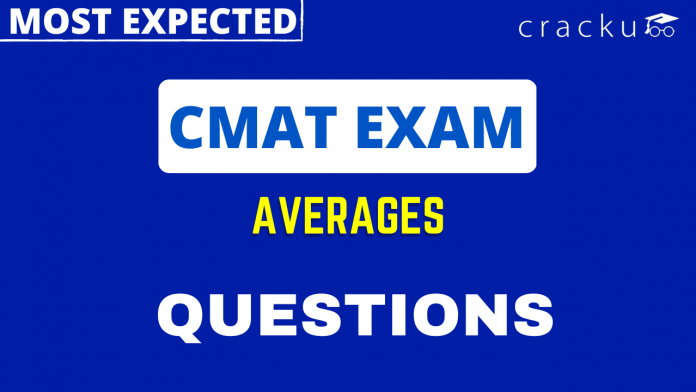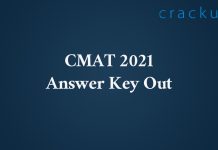Important CMAT Averages Questions [Downlaod PDF]
Averages is one of the most important topics in the CMAT, and also it is a important section. One can utilize this article which consists of the most important questions regarding Averages. Cracku provides you with the Top 20 very Important Averages Questions for CMAT based on the questions asked in previous exam papers. Click on the link below to download the Average Questions for CMAT PDF with detailed answers.
Download Averages Questions for CMAT
Enroll to CMAT 2023 Crash Course
Question 1: A fruit seller has a sale of ₹10,435, ₹9,927,₹10,855 ₹10,230 and ₹9,562 for five consecutive months.How much sale (in ₹) must he have in the sixth month so that he gets an average sale of ₹10,500?
a) 9,231
b) 8,231
c) 8,991
d) 11,991
1) Answer (D)
Solution:
As we know,
Average = $\frac{Sumofobservation}{total\ number\ of\ observation}$
Let the sale of 6th month be x
Average = $\frac{\left(10435+9927+10855+10230+9562+x\right)}{6}=10500$
= $51009\ +\ x=63000$
x = 11991
Hence, option D is correct.
Question 2: The average weight of 6 people increased by 2.5 kg when a new person came in place of other person weighing 55 kg. what can be the weight of new person (in kg)?
a) 70
b) 62.5
c) 60
d) 75.5
2) Answer (A)
Solution:
Total weight increased = number of persons $\times\ $ increased weight
i.e;$6\times\ 2.5=15$
Weight of new person = weight of replaced person + Total increased weight
i.e; 55 + 15 = 70 kg
Hence, Option A is correct.
Question 3: The average of eleven numbers is 56. The average of first three numbers is 52 and that of next five numbers is 60. The 9th and 10th number are 3 and 1 more than the 11th number respectively. What is the average of 9th and 11th numbers?
a) 53.5
b) 52
c) 52.5
d) 54
3) Answer (A)
Solution:
The average of first three numbers is 52.
Sum of the first three numbers = 52 x 3 = 156
The average of next five numbers is 60.
Sum of the next five numbers = 60 x 5 = 300
Let the 11th number be ‘n’.
The average of eleven numbers is 56.
Sum of the eleven numbers = 56 x 11 = 616
156 + 300 + (n + 3) + (n + 1) + n = 616
3n + 460 = 616
3n = 156
n = 52
Average of 9th and 11th numbers = $\frac{(n+3)+n}{2}$
= $\frac{107}{2}$
= 53.5
Hence, the correct answer is Option A
Question 4: The average of 23 numbers is 51. The average of first 12 numbers is 49 and the average of last 12 numbers is 54. If the twelfth number is removed, then the average of the remaining numbers (correct to two decimal places) is:
a) 53:25
b) 50.45
c) 51.75
d) 52.65
4) Answer (B)
Solution:
The average of 23 numbers is 51.
Sum of the 23 numbers = 51 x 23 = 1173…….(1)
The average of first 12 numbers is 49.
Sum of the first 12 numbers = 49 x 12 = 588
Sum of the first 11 numbers + 12th number = 588…..(2)
The average of last 12 numbers is 54.
Sum of the last 12 numbers = 54 x 12 = 648
12th number + Sum of the last 11 numbers = 648…..(3)
Adding (2) and (3),
Sum of the first 11 numbers + 12th number + 12th number + Sum of the last 11 numbers = 588 + 648
(Sum of the first 11 numbers + 12th number + Sum of the last 11 numbers) + 12th number = 1236
Sum of the 23 numbers + 12th number = 1236
1173 + 12th number = 1236
12th number = 63
Required average = $\frac{1173-63}{22}$
= 50.4545
Hence, the correct answer is Option B
Question 5: The average weight of a certain number of students in a class is 55.5 kg. If 4 students with average weight 60 kg join the class, then the average weight of all students in the class increases by 360 g. The number of students in the class, initially, is:
a) 46
b) 31
c) 41
d) 36
5) Answer (A)
Solution:
Let the initial number of students = n
Average of the weight of ‘n’ students = 55.55
Sum of the weight of ‘n’ students = 55.55n
Sum of the weight of 4 students = 60 x 4 = 240 kg
According to the problem,
$\frac{55.55n+240}{n+4}=55.55+\frac{360}{1000}$
$\frac{55.55n+240}{n+4}=55.55+0.36$
$\frac{55.55n+240}{n+4}=55.86$
55.55n + 240 = 55.86n + 223.44
0.36n = 16.56
n = 46
The initial number of students = n = 46
Hence, the correct answer is Option A
Question 6: The average monthly salary of 60 employees of a factory is ₹29900. If two officers are getting ₹90000 each and the average salary of 8 supervisors is ₹65000, then what is the average salary (in ₹) of the remaining employees?
a) 22680
b) 29080
c) 21080
d) 21880
6) Answer (D)
Solution:
The average monthly salary of 60 employees of the factory is ₹29900.
Total monthly salary of 60 employees of the factory = 29900 x 60 = ₹1794000
Two officers are getting ₹90000 each.
Sum of the salary of two officers = 2 x 90000 = ₹180000
The average salary of 8 supervisors is ₹65000.
Total salary of 8 supervisors = 65000 x 8 = ₹520000
Total salary of remaining 50 employees of the factory = 1794000 – 180000 – 520000 = ₹1094000
Average of remaining 50 employees of the factory = $\frac{1094000}{50}$ = ₹21880
Hence, the correct answer is Option D
Question 7: The average daily production of toys in a factory in the month of December is 512. If the average production during first 20 days is 515 and that of the last 13 days is 510, then what is the average of production on 19 and 20 December?
a) 1058
b) 513
c) 529
d) 512
7) Answer (C)
Solution:
The average daily production of toys in a factory in the month of December is 512.
Total production of toys in the month of December = 512 x 31 = 15872……..(1)
The average production during first 20 days is 515.
Total production during first 20 days = 515 x 20 = 10300
Production during first 18 days + 19 December + 20 December = 10300……..(2)
The average production during last 13 days is 510.
Total production during last 13 days = 510 x 13 = 6630
19 December + 20 December + Production during last 11 days = 6630……..(3)
Solving (2) + (3) – (1), we get
19 December + 20 December = 10300 + 6630 – 15872
19 December + 20 December = 1058
Total production on 19 and 20 December = 1058
Average of production on 19 and 20 December = $\frac{1058}{2}$ = 529
Hence, the correct answer is Option C
Question 8: The average of 40 numbers is 36. The average of the first 25 numbers is 31 and the average of last 16 numbers is 43. Find the 25th number.
a) 21
b) 23
c) 24
d) 22
8) Answer (B)
Solution:
Given, average of 40 numbers = 36
$\Rightarrow$ Sum of 40 numbers = 36 x 40 = 1440………………(1)
The average of the first 25 numbers is 31
$\Rightarrow$ Sum of first 25 numbers = 31 x 25 = 775
$\Rightarrow$ Sum of first 24 numbers + 25th number = 775 ……(2)
The average of last 16 numbers is 43
$\Rightarrow$ Sum of last 16 numbers = 43 x 16 = 688 ………….(3)
Adding equations (2) and (3),
Sum of first 24 numbers + 25th number + Sum of last 16 numbers = 775 + 688
$\Rightarrow$ Sum of first 24 numbers + Sum of last 16 numbers + 25th number = 1463
$\Rightarrow$ Sum of 40 numbers + 25th number = 1463
$\Rightarrow$ 1440 + 25th number = 1463
$\Rightarrow$ 25th number = 23
Hence, the correct answer is Option B
Question 9: The average of four consecutive odd natural numbers is eight less than the average of three consecutive even natural numbers. If the sum of these three even numbers is equal to the sum of above four odd numbers, then the average of four original odd numbers is:
a) 32
b) 24
c) 18
d) 36
9) Answer (B)
Solution:
Let the four consecutive odd natural numbers are a, a+2, a+4, a+6
Let the three consecutive even natural numbers are b, b+2, b+6
Average of four consecutive odd natural numbers = $\frac{a+a+2+a+4+a+6}{4}=\frac{4a+12}{4}=a+3$
Average of three consecutive even natural numbers = $\frac{b+b+2+b+4}{3}=\frac{3b+6}{3}=b+2$
The average of four consecutive odd natural numbers is eight less than the average of three consecutive even natural numbers.
$\Rightarrow$ $a+3=b+2-8$
$\Rightarrow$ $b-a=9$ ………(1)
The sum of the three even numbers is equal to the sum of four odd numbers.
$\Rightarrow$ $b+b+2+b+4=a+a+2+a+4+a+6$
$\Rightarrow$ $3b=4a+6$
$\Rightarrow$ $3b-4a=6$ ……(2)
Solving 3(1)-(2) we get, $a = 21$
$\therefore\ $Average of four consecutive odd natural numbers = $a+3=21+3=24$
Hence, the correct answer is Option B
Question 10: The average of four consecutive even numbers is 27. By adding which number does the average become 28?
a) 32
b) 30
c) 33
d) 29
10) Answer (A)
Solution:
Let the four consecutive even numbers are a, a+2, a+4, a+6
Average of four consecutive even numbers is 27
$\Rightarrow$ $\frac{a+a+2+a+4+a+6}{4}=27$
$\Rightarrow$ $\frac{4a+12}{4}=27$
$\Rightarrow$ $a+3=27$
$\Rightarrow$ $a=24$
The four consecutive even numbers are 24, 26, 28, 30
Let the number which is to be added = p
After adding p, the new average is 28
$\Rightarrow$ $\frac{24+26+28+30+p}{5}=28$
$\Rightarrow$ $108+p=140$
$\Rightarrow$ $p=32$
$\therefore\ $The required number which is to be added is 32
Hence, the correct answer is Option A
Question 11: Several students have taken an exam. There was an error in the answer key which affected the marks of 48 students, and their average marks reduced from 78 to 66. The average of remaining students increased by 3.5 marks. This resulted the reduction of the average of all students by 4.5 marks. The number of students that attended the exam is:
a) 96
b) 84
c) 100
d) 93
11) Answer (D)
Solution:
Let the total number of students = T
Number of students whose average is reduced = 48
Number of students whose average is increased = T-48

Using Alligation and Mixture rule,
Ratio of 48 and T-48 = 16 : 15
$=$> $\frac{48}{T-48}=\frac{16}{15}$
$=$> T-48 = 45
$=$> T = 93
$\therefore\ $Total number of students = 93
Hence, the correct answer is Option D
Another method
Let the total number of students = T
Without error
Average of 48 students = 78
Sum of 48 students = 78 x 48
Let average of remaining T-48 students = p
Sum of T-48 students = p(T-48)
Total marks = (78 x 48) + p(T-48)
Let the average of total students = q
$\Rightarrow$ (78 x 48) + p(T-48) = Tq………(1)
With error
Average of 48 students = 66
Sum of 48 students = 66 x 48
Average of T-48 students = (p+3.5)
Sum of T-48 students = (p+3.5)(T-48)
Total marks = (66 x 48)+(p+3.5)(T-48)
Average of total students = (q-4.5)
$\Rightarrow$ (66 x 48)+(p+3.5)(T-48) = T(q-4.5)
$\Rightarrow$ (66 x 48)+(p+3.5)(T-48) = Tq – 4.5T
$\Rightarrow$ (66 x 48)+(p+3.5)(T-48) = (78 x 48) + p(T-48) – 4.5T [From (1)]
$\Rightarrow$ (p+3.5)(T-48) – p(T-48) + 4.5T = (78 x 48) – (66 x 48)
$\Rightarrow$ (T-48)(p+3.5-p) + 4.5T = 48(78 – 66)
$\Rightarrow$ (T-48)3.5 + 4.5T = 48 x 12
$\Rightarrow$ 3.5T – 48 x 3.5 + 4.5T = 48 x 12
$\Rightarrow$ 8T = 48 x 15.5
$\Rightarrow$ T = 93
Total number of students = 93
Hence, the correct answer is Option D
Question 12: The average age of 16 students in a college is 20. Out of them, the average age of 5 students is 20 and the average age of the other 10 students is 20.4. Find the age of the 16th college student.
a) 24
b) 16
c) 20
d) 22
12) Answer (B)
Solution:
Given,
Average age of 16 students = 20
$=$> Sum of the ages of 16 students = 16 x 20 = 320
Average age of 5 students = 20
$=$> Sum of the ages of 5 students = 5 x 20 = 100
Average age of other 10 students = 20.4
$=$> Sum of the ages of other 10 students = 10 x 20.4 = 204
$\therefore\ $Age of the 16th student = Sum of the ages of 16 students – Sum of the ages of 15 students = 320 – (100+204) = 16
Hence, the correct answer is Option B
Question 13: A batsman in his 11th inning makes a score of 77 runs, there by increasing his average scores by 3. What is his average score after the 11th inning?
a) 46
b) 47
c) 48
d) 49
13) Answer (B)
Solution:
Let the average for scores of 10 innings = a
Sum of the scores of 10 innings = 10a
Score in the 11th inning = 77
$=$> Sum of the scores of 11 innings = 10a + 77
Average increased by 3 after 11th inning
$=$> Average of the scores of 11 innings = a + 3
$=$> Sum of the scores of 11 innings = 11(a+3)
$=$> 11(a+3) = 10a + 77
$=$> 11a + 33 = 10a + 77
$=$> 11a – 10a = 77 – 33
$=$> a = 44
$\therefore\ $Average of the scores after 11th inning = a + 3 = 44 + 3 = 47
Hence, the correct answer is Option B
Question 14: In set of three numbers,the average of the first two numbers is 7, the average of the last two numbers is 10, and the average of the first and the last numbers is 14. What is the average of the three numbers?
a) 31/3
b) 25/4
c) 29/4
d) 37/3
14) Answer (A)
Solution:
Let the three numbers are a, b, c respectively
Given,
Average of the first two numbers = 7
$=$> $\frac{a+b}{2}=14$
$=$> $a+b=28$ ……………………..(1)
Average of the last two numbers = 10
$=$> $\frac{b+c}{2}=10$
$=$> $b+c=20$ ……………………..(2)
Average of the first and last number = 14
$=$> $\frac{a+c}{2}=14$
$=$> $a+c=28$ ……………………..(3)
Adding (1), (2), (3)
$2a+2b+2c=14+20+28$
$=$> $2a+2b+2c=62$
$=$> $a+b+c=31$
Average of the three numbers = $\frac{a+b+c}{3}$ = $\frac{31}{3}$
Hence, the correct answer is Option A
Question 15: In a company with 600 employees, the average age of the male employees is 42 years and that of the female employees is 41 years. If the average age of all the employees in the company is 41 years 9 months, then the number of female employees is:
a) 350
b) 150
c) 250
d) 450
15) Answer (B)
Solution:
Given, total number of employees in the company = 600
Average of all employees = 41 years 9 months = 41 + $\frac{9}{12}$ years = $41\frac{3}{4}$ years

Using alligation and mixture rule,
The ratio of male employees to female employees = 3 : 1
$\therefore\ $Number of female employees = $\frac{1}{3+1}\times600=\frac{1}{4}\times600=150\ $
Hence, the correct answer is Option B





